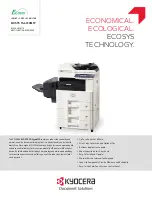
Chapter 2
2-24
The machine picks up sheets of paper from inside the cassette one by one. The machine uses the cassette paper sensor to check the presence/absence of paper
inside the cassette.
Picking Up Paper from the Manual Feeder
The machine picks up the sheet of paper from the manual feeder. (Only one sheet of paper may be placed in the manual feeder at a time.) The machine uses the
manual feeder paper sensor to check the presence/absence of paper in the manual feeder, and uses the registration roller to move the paper inside the machine.
Moving the Print Paper
After picking up the paper, the machine moves it all the way to the delivery assembly by way of the fixing assembly. The registration shutter makes sure that
the paper does not move askew, and the paper width sensor in the path checks the paper to find out if it is of small size.
Controlling the Speed of Movement
The machine switches the speed at which the paper is moved according to the type of paper to prevent poor fixing.
Paper loop control
The machine keeps the print paper arching to a specific degree between the fixing pressure roller and the ETB to prevent image faults and transport faults.
Automatic release of fixing pressure mechanism
The machine is equipped with a mechanism to automatically release the engagement between the fixing assembly pressure roller and the fixing film to facilitate
removal of a jam.
2.5.2.2 Picking Up Paper from the Cassette
0010-6133
LBP5000 / LBP5100
The machine makes sure no more than a single sheet of print paper is picked up from the cassette.
The presence/absence of paper inside the cassette is checked by the cassette paper sensor (SR2).
To prevent double feeding of print paper, the machine uses a slope separation/pad separation method.
1) When the print command arrives from the video controller, the DC controller turns on the pickup motor (M3).
2) The pickup solenoid (SL1) goes on, and the drive of the pickup motor arrives to rotate the pickup roller.
3) The holding plate is held up by the work of a spring, thus keeping the stack of sheets at a level that permits pickup. The pickup roller rotates to pick up a single
sheet of paper, and moves it forward to the inside of the machine. At this time, the slope/pad separation mechanism makes sure no more than one sheet of paper
is picked up.
2.5.2.3 Picking Up Paper from the Manual Feeder
0010-6135
LBP5000 / LBP5100
The manual feeder accepts a single sheet of paper inserted into the manual feeder slot, and moves it into the machine.
The machine's manual feeder slot is not equipped with a pickup roller, and the registration roller functions as the pickup roller.
The printer paper that is placed in the manual feeder slot is checked by the manual feeder paper sensor (SR3).
The following is the sequence used to pick up paper from the manual feeder:
1) When a sheet of print paper is placed in the manual feeder slot while the machine is in a standby state, the manual feeder paper sensor (SR3) detects the presence
of the paper.
2) As a result, the DC controller drives the pickup motor (M3; for a maximum of 5 sec), thus moving the paper about 5 mm so that it is held by the registration roller.
3) Thereafter, the print paper is moved farther inside the machine by the work of the registration roller.
2.5.2.4 Moving the Print Paper
0010-6136
LBP5000 / LBP5100
The machine moves the single sheet of paper that has been picked up as far the fixing assembly.
The paper path of the fixing assembly is equipped with a paper width sensor to prevent overheating at ends of the drums by recognizing paper that is 190 mm or
less in width.
The following is the sequence of operation used to move print paper:
1) When the paper is inside the machine, the registration shutter makes sure that the paper moves without any skew.
2) The print paper then receives the toner image from the photosensitive drum, and is moved to the fixing/delivery assembly.
3) The machine removes any warping from the paper using the drive of the fixing/delivery motor.
4) The print paper is moved between the fixing film an the fixing pressure roller so that the toner that has been deposited on it is permanently fused to its fibers. It
is then discharged to the delivery tray.
Removing the Skew by the Registration Shutter
1) The print paper arriving in the registration roller assembly butts against the registration shutter so that its leading edge is aligned.
2) The registration shutter is held in place by the force of a spring, and will not open unless a certain degree of force is applied, thus causing the print paper to arch.
3) The arching print paper takes on extra body, enough to push up the registration shutter and be free of any skew.
Summary of Contents for LBP5000 Series
Page 1: ...Feb 26 2007 Service Manual LBP5000 5100 Series...
Page 2: ......
Page 6: ......
Page 14: ...Contents...
Page 15: ...Chapter 1 PRODUCT DESCRIPTION...
Page 16: ......
Page 18: ......
Page 28: ......
Page 29: ...Chapter 2 TECHNICAL REFERENCE...
Page 30: ......
Page 33: ...Contents 2 8 3 2 Overview of the Block 2 39...
Page 34: ......
Page 74: ...Chapter 2 2 40 IC12 Logic IC Converts voltage levels Notation Name Description...
Page 75: ...Chapter 3 DISASSEMBLY AND ASSEMBLY...
Page 76: ......
Page 80: ......
Page 122: ......
Page 123: ...Chapter 4 MAINTENANCE AND INSPECTION...
Page 124: ......
Page 126: ......
Page 132: ......
Page 133: ...Chapter 5 TROUBLESHOOTING...
Page 134: ......
Page 136: ......
Page 141: ...Chapter 5 5 5 F 5 9...
Page 142: ...Chapter 5 5 6 F 5 10...
Page 149: ...Chapter 6 APPENDIX...
Page 150: ......
Page 152: ......
Page 161: ...Feb 26 2007...
Page 162: ......
















































